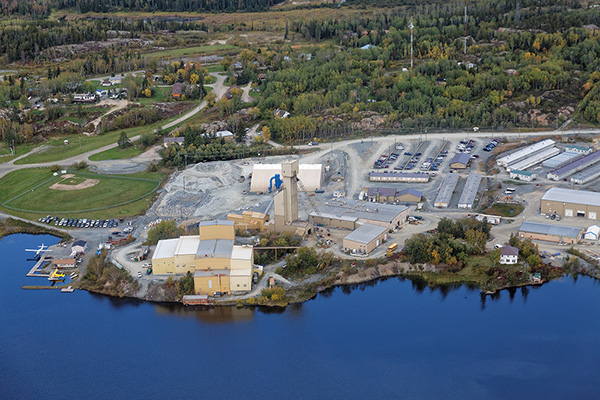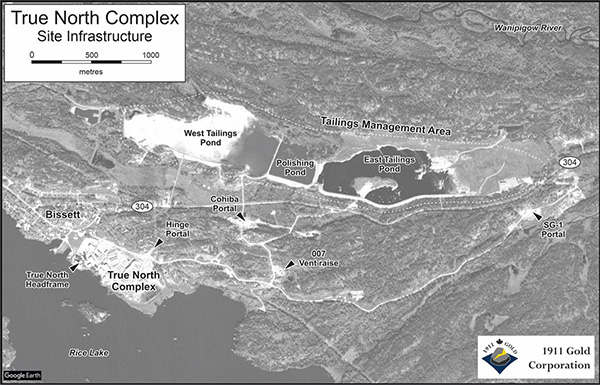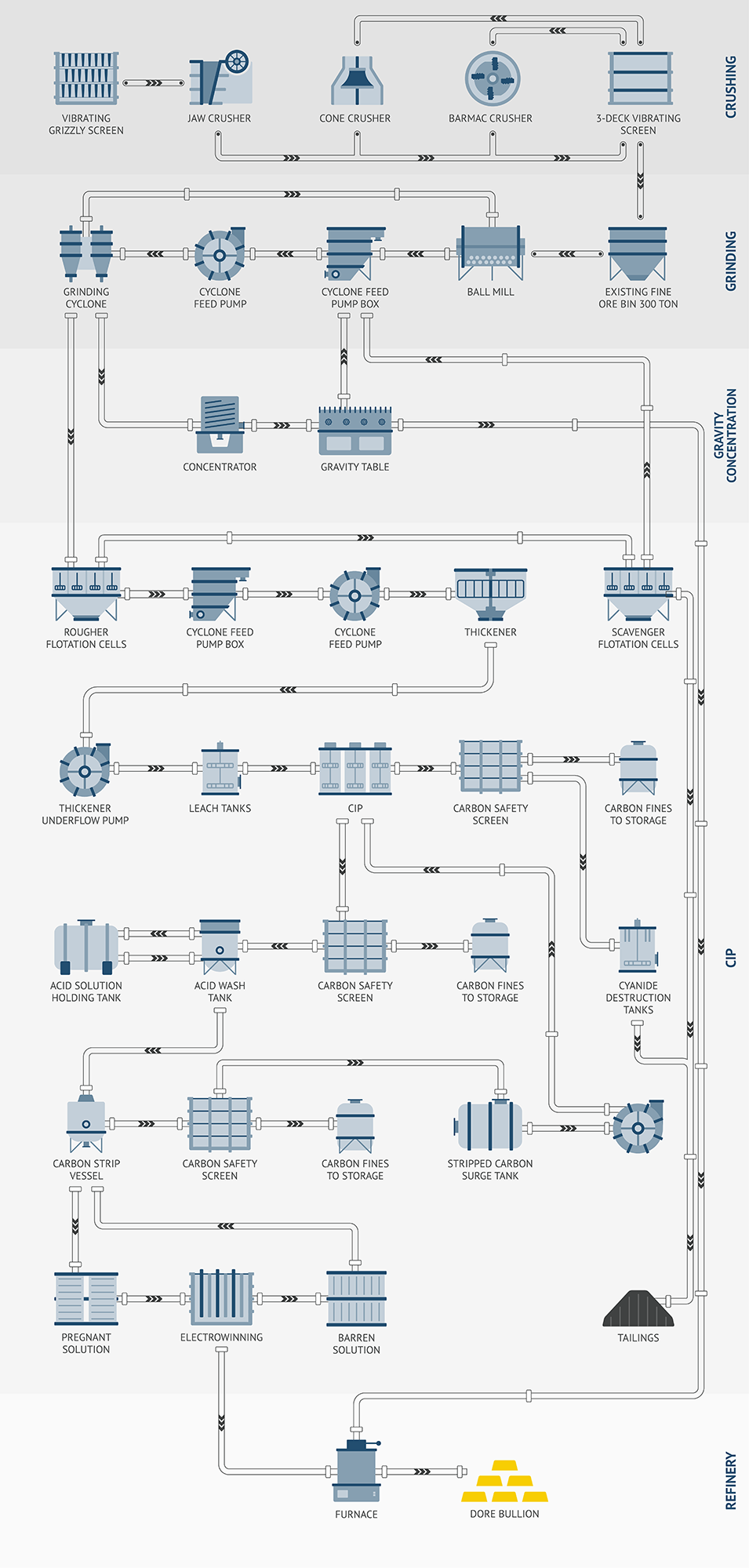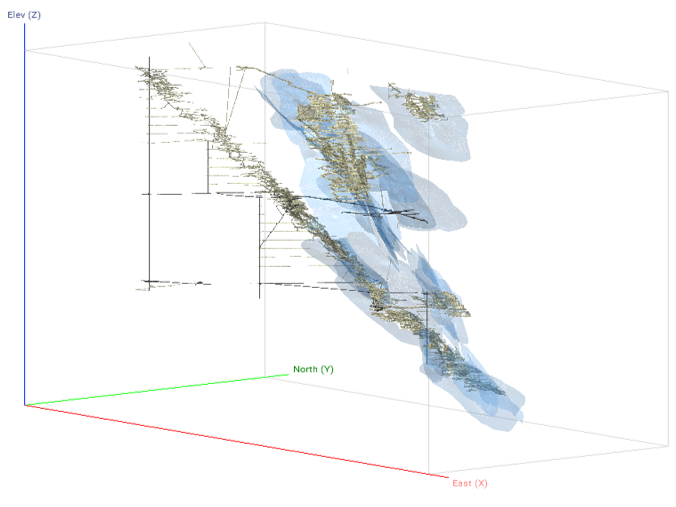- Overview
- Processing Facility
- Tailings Operation
- Underground Mine
- True North Gold Deposit
As 1911 Gold’s flagship asset, the True North Complex is a key component of our overall corporate strategy to develop a district-scale gold exploration and mining operation around a centralized ore processing facility in the Rice Lake greenstone belt.
The True North Complex includes a modern, fully-permitted 1,300 tonnes per day processing facility, tailings management area and reprocessing operation, underground mine infrastructure (currently under temporary closure), and the True North Gold Deposit.


Existing infrastructure at True North, combined with the high-grade mineral resource, provides a solid foundation on which to build a modern long-life mining and processing operation. The site also includes the necessary infrastructure to maintain operations, including all-season road access, grid hydroelectric power and broadband communications, as well as on-site maintenance shops, assay laboratory, warehouse, fuel storage facilities and administrative offices. The site also includes a 200-room camp facility, including kitchen, dining, recreation and fitness facilities.
The True North Complex is located adjacent to the town of Bissett on the north shore of Rice Lake, approximately 150 kilometres northeast of the capital city of Winnipeg, Manitoba. It is situated on mineral dispositions held 100% by the Company, comprising two contiguous Mineral Leases (ML63 and ML13433), totaling 1,092 hectares.
The original gold discovery in the Rice Lake district was made in 1911 by Duncan Twohearts, an indigenous trapper from the Sagkeeng First Nation, who identified an outcropping of vein quartz on the north shore of Rice Lake – the discovery outcrop for the True North Gold Deposit. Duncan Twohearts wrapped his find in a piece of blue denim, marking the first significant discovery of gold in the Province of Manitoba.
The original mining claim, named San Antonio, was staked on May 17, 1911, followed in August 1912 by the establishment of a small stamp mill on the adjacent Gabrielle mining claim – the first gold mill erected in Manitoba. Subsequent mine developments in the Rice Lake district took place in two main stages (1923–1968 and 1998–2017), with 23 zones eventually recording production, amounting to approximately 2.3 million ounces of gold.
Of historical note, the True North mine has produced more than 2 million ounces of gold over a mine life that has spanned close to 100 years, including 36 years of continuous production (1932–1968) from the historical San Antonio Gold Zone.

The True North Complex includes a modern, fully-permitted 1,300 tonnes-per-day ore processing facility, comprised of crushing, milling, centrifugal gravity concentration and flotation circuits. Concentrates from the gravity circuit are upgraded on a shaker table for direct-smelting, whereas flotation concentrates are reground, thickened and then leached in a three-stage leach circuit. Dissolved gold is recovered by six-stage carbon-in-pulp (CIP) circuit, followed by conventional pressure strip, electrowinning and smelting in an electric induction furnace. Gold is poured into doré bars and shipped to a refinery prior to being sold.

The original processing facility at the True North site, constructed in 1931–32, was destroyed by fire in 1980 and was subsequently reconstructed in 1996–97, with an operating capacity of 900 tonnes per day. Mill capacity was increased to 2,300 tonnes per day in 2011; however, it has since been scaled back to 1,300 tonnes per day. Additional crushing capability will return the plant to 2,300 tonnes per day capacity.
Current process plant recovery is name-plated at 93.5% based on a feed grade of 5.5 g/t Au, historically ranging up to 96–97% with higher feed grades from mined ore.
From 2018 through 2022, the Company recovered gold from historical tailings at Rice Lake, this seasonal (April to November) operation has produced approximately 24,742 ounces of gold. There is a remaining estimated resource of 15,166 ounces of gold.
Production from True North Tailings Operation:
| |
2017 |
2018 |
2019 |
2020 |
2021 |
2022 |
| Tonnes Processed |
80,848 |
230,427 |
222,134 |
224,475 |
269,829 |
182,746 |
| Grade Processed |
1.4 g/t |
0.9 g/t |
1.0 g/t |
0.9 g/t |
0.6 g/t |
0.6 g/t |
| Gold Processed |
3,616 oz |
6,754 oz |
6,917 oz |
6,201 oz |
5,466 oz |
3,775 oz |
| Gold Recovered |
3,285 oz |
4,398 oz |
6,081 oz |
4,711 oz |
3,763 oz |
2,504 oz |
Scroll right to view more
This operation utilized an excavator to windrow tailings within the Tailings Management Area (TMA) for dewatering and then loaded the material onto 36-tonne trucks for transport to the processing facility. Tailings were then off-loaded into a screened feed hopper and conveyed directly to the grinding circuit, bypassing the crushing circuit. Tailings were processed at a rate of 55 tonnes per hour with a target rate of 1,300 tonnes per day.
The TMA is located 1.6 kilometres northeast of the processing facility in an area naturally defined by bedrock ridges around the perimeter of a previously boggy area. It includes west and east impoundments, totaling 110 hectares in area, separated by polishing pond 11 hectares in area. The current dikes and embankments were constructed in stages to industry standards, beginning in 1996, with the most recent expansion completed in 2014.
Beginning in 1997, tailings containing unrecovered gold were pumped as slurry via pipeline to the TMA from the processing facility. The potential to economically reprocess these tailings to recover gold was identified after a review of drilling undertaken in 2014, which indicated an average grade of 1.47g/t Au. Additional sampling was completed in 2016 to evaluate the resource. Tailings reprocessing commenced in 2016 with a Probable Reserve of 1,062,000 tonnes at 0.96 g/t Au (containing 32,400 ounces of gold) and an Indicated Resource (inclusive of Mineral Reserves) of 1,940,000 tonnes at 0.82 g/t Au (containing 51,000 ounces of gold).
An updated Mineral Resource Estimate for the True North tailing reprocessing operation was produced in March 2018. Assay results from 138 auger and percussion drillholes spaced approximately 60 metres by 30 metres were used to model the tailings mineral resource. Details on the methodology of the Mineral Resource Estimate can be found in the Technical Report dated March 31, 2018.
True North Tailings Mineral Resources (March 2018):
| Category |
Tonnes (k) |
Au opt |
Au g/t |
Au koz |
| Indicated |
1,789 |
0.024 |
0.83 |
48 |
| Inferred |
28 |
0.024 |
0.81 |
0.7 |
Scroll right to view more
Underground infrastructure at the True North Complex includes the ‘main’ (True North) mine, accessed via a 1,219 metre two-compartment shaft (A-shaft), originally brought into service in 1934 and subsequently deepened to its present depth in 1997. An internal winze (D-shaft) and ramp system extend the workings in the main mine to 1,675 metres vertical depth and are connected to A-shaft via a 1,400-metre-long tramway on the 26th (1,190 metre) level. A-shaft is equipped with a modern headframe, dual-drum hoist and 4.5 tonne skip. Several ramp-access mines, including SG-1, Hinge and Cohiba, were developed between 2005 and 2010 on satellite deposits located northeast and east of the main mine.
Underground development at True North began over 100 years ago, when prospect shafts were sunk during the 1920’s and 1930’s on several gold showings, with the San Antonio (True North) mine being brought into commercial production. Elsewhere in the district, significant mine development and production took place between 1927 and 1951 at Central Manitoba, Gunnar and Ogama-Rockland, which have since been closed and partially reclaimed. Historically, shrinkage stoping was the principal mining method utilized in the district, although long-hole stoping and mechanized cut-and-fill were employed more recently at True North.

The True North Gold Deposit is a classical Archean orogenic gold deposit, consisting of quartz-carbonate vein systems hosted by brittle-ductile shear zones and faults in volcanic and sedimentary rocks (greenstones). The deposit is hosted by a north-younging, moderately inclined, succession of volcanic and sedimentary rocks, belonging to the 2.73–2.72 Ga Gem assemblage. At Rice Lake, this assemblage includes volcanic sandstone and conglomerate, tholeiitic basalt flows and gabbro sills and dacitic volcaniclastic rocks, intruded by various felsic porphyry dikes.
The most important host for gold mineralization is a layered gabbro sill known as the San Antonio Mine unit (host to the main True North or Rice Lake deposit), but significant mineralization is also hosted by overlying basalt flows (007, 710-711 and SG1 deposits) and dacitic volcaniclastic rocks (Hinge and Cohiba deposits). The South Gabbro unit has not been drill tested. Orebodies within these deposits were accessed via the True North shaft and underground tramway, or from surface declines, the latter including the Hinge, 007 and SG1 declines.
An updated Mineral Resource Estimate for True North was produced in 2024, based on data from 3,157 surface and underground diamond drillholes (30,525 assay samples), and 30,202 channel sample strings from underground workings (114,756 assay samples). Wireframe models were constructed for 66 vein sets. Details on the methodology of the Mineral Resource Estimate can be found in the Technical Report dated December ??, 2024.
True North Underground Mineral Resources
Table 1: Mineral Resource Estimate Reported within 2.25 g/t Au Mineral Resource Constraining Envelopes
| Category |
Tonnes |
Au opt |
Au g/t |
Au oz |
| Indicated |
3,516,000 |
0.142 |
4.41 |
499,000 |
| Inferred |
5,490,000 |
0.117 |
3.65 |
644,000 |
Scroll right to view more
| Sensitivity
Gold Grade
|
Indicated |
Inferred |
| Tonnage |
Gold Grade |
Contained Gold |
Tonnage |
Gold Grade |
Contained Gold |
| (g/t) |
(t) |
(g/t) |
(oz) |
(t) |
(g/t) |
(oz) |
| 2.00 |
2,781,000 |
5.23 |
468,000 |
4,852,000 |
3.96 |
618,000 |
| 2.25 |
2,530,000 |
5.54 |
451,000 |
4,404,000 |
4.14 |
587,000 |
| 2.50 |
2,255,000 |
5.93 |
430,000 |
3,754,000 |
4.45 |
537,000 |
| 3.00 |
1,751,000 |
6.85 |
386,000 |
2,726,000 |
5.10 |
447,000 |
| 3.50 |
1,368,000 |
7.86 |
346,000 |
2,031,000 |
5.75 |
375,000 |
| 4.00 |
1,093,000 |
8.91 |
313,000 |
1,527,000 |
6.42 |
315,000 |
Scroll right to view more
Note: The block tabulations included above do not constitute mineral resource estimates and are included to illustrate block grade sensitivity within the 2.25 g/t Au resource constraining envelopes
Figure: Block model - 3D Isometric View looking North






